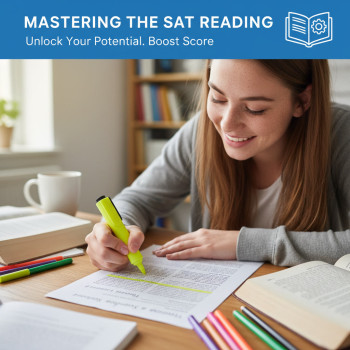What Score Reports From Practice Tests Actually Tell You
When you get a practice test score back, it’s easy to feel a surge of emotion. A high score can make you float for a day; a low score can make you spiral. But the raw number — 1200, 1400, 1000 — is only the first note in a much richer song. A good score report is like a diagnostic scan: it tells you where your engine is running hot, where the oil needs changing, and which dashboard lights you can safely ignore for now.
In this post I’ll walk you through how to read score reports from practice SATs so you can convert numbers into action. We’ll cover what each line really means, how to interpret subscores and question-level feedback, how to spot trends, and what to do next. I’ll also show a sample score breakdown table, provide concrete examples, and explain how personalized help — for example, Sparkl’s personalized tutoring with 1-on-1 guidance, tailored study plans, expert tutors, and AI-driven insights — can amplify the value of the data.
The three levels of information your score report gives you
Think of a report as a layered map. Each layer gives different kinds of direction:
- Macro level: overall score and section scores (Evidence-Based Reading and Writing, Math). This tells you where you stand relative to the goal you set.
- Micro level: subscores, cross-test scores, and section-level timing. These explain which content areas or skills are strong or weak.
- Item level: question types, specific questions missed, and often difficulty level. This tells you exactly what to practice next.
Every layer matters, but too many students get stuck on the macro level and miss the real usefulness of item-level data. Let’s dig into each one.
Macro: The overall and section scores
The SAT gives you a total score (400–1600) and two section scores: Evidence-Based Reading and Writing (EBRW) and Math (200–800 each). These are what colleges look at and what most students focus on first. But here’s the nuance: two students can have the same overall score for very different reasons — one might be a balanced 650/650, and another might be 750/550. The action plan for each changes entirely.
When you read your section scores, ask: are you closer to improving the weaker section enough to raise the total faster than pushing marginal gains in your stronger section? Usually, focusing on the weaker section yields higher returns — but not always. If your goal is a specific scholarship or college that requires a minimum in a subject (for example, a math-intensive program), that requirement shifts your priorities.
Micro: Subscores and cross-test scores
Subscores break a big section into smaller skills: command of evidence, words in context, heart of algebra, problem solving and data analysis, and passport to advanced math (names vary slightly by report format). These scores often range 1–15 or are shown as percentiles or score ranges depending on the test platform.
What these reveal is the skill-specific gap. You might be great at algebra but consistently lose points on data analysis questions. That tells you which topics to prioritize, and how to design efficient practice sessions: instead of doing a whole math test every day, focus on focused sets of data analysis problems until your accuracy climbs.
Item-level data: where the gold is
Item-level feedback shows which exact questions you missed and why. Many practice platforms also tag each question by difficulty and type. This is the clearest route to improvement because it tells you the exact habits to change: careless errors, vocabulary gaps, algebra foundations, or timing problems.
When you review items, ask three questions for each missed question:
- Was the error conceptual (I didn’t know the math)?
- Was it procedural (I knew the steps but executed them wrong)?
- Was it strategic (timing, misreading, or guessing without elimination)?
The corrective action depends on the answer. Conceptual gaps need mini-lessons and worked examples. Procedural issues need deliberate practice and slow, error-free repetitions. Strategic mistakes often need time drills and process checklists.
How to read a typical practice test score report — an example
Below is a simplified sample of a practice test report. It mirrors the kind of breakdown most reputable platforms will give you: total, section scores, subscores, percentiles, and question-type performance.
| Measure | Score / Range | Notes |
|---|---|---|
| Total Score | 1240 | EBRW 650 | Math 590 |
| EBRW Subscores | Reading 33 / Writing & Language 34 | Stronger on grammar than on evidence-based reading |
| Math Subscores | Heart of Algebra 12 / Problem Solving 7 / Advanced Math 9 | Big weakness in problem solving and data analysis |
| Percentile | 76th | Solid score, room to move into 85–90th with focused work |
| Timing | Last 10 Math questions rushed | Likely timing issue under pressure |
That table gives a lot to work with. The total score is mid-1200s — respectable — but subscores reveal math is the limiting factor. Within math, problem solving (often data-heavy, multi-step items) is the most concerning. The test-taker can now target: data interpretation, ratios/proportions within context, and time management for the last quarter of the math section.
Translating report findings into a study plan
A score report is only valuable if it leads to sensible action. Here’s a template to turn insights into a week-by-week plan.
Step 1: Prioritize weaknesses
Use the 80/20 rule. Which 20% of problem types are causing 80% of the missed points? If your report shows you miss most reading questions that require evidence-based inference, that’s your green light: spend more study time on those and less on areas where you’re routinely correct.
Step 2: Set measurable, short-term goals
Instead of “get better at reading,” try: “increase correct rate on inference questions from 50% to 75% in six weeks.” Precise goals help you measure progress and keep sessions purposeful.
Step 3: Build deliberate practice routines
Deliberate practice means focused work on specific skills with immediate feedback. For example:
- Two 25-minute sessions per week on data analysis problems with timed conditions.
- Three weekly reading passages focused only on inference questions, followed by detailed error analysis.
- Weekly full-length practice test every two weeks to integrate gains and practice endurance.
Step 4: Track progress and iterate
After two weeks of targeted work, take a short practice set and check your subscores. If your accuracy improves on targeted item types but total timing gets worse, add pacing drills. If accuracy doesn’t budge, revisit basics — sometimes we skip foundational concepts in the rush to see improvement.
Common pitfalls when interpreting score reports
Reading a score report isn’t always straightforward. Here are mistakes students make and how to avoid them.
- Focusing only on the total score. The total is a summary, not a plan. Dig to item-level issues.
- Overreacting to small fluctuations. A single practice test can be noisy. Look for trends over 3–5 tests.
- Neglecting timing data. Getting the right answer matters, but so does getting it within the allotted time. Timing patterns tell you when pressure affects performance.
- Assuming all incorrect answers are equal. Some misses cost more — a careless slip on an easy question is easier to fix than steady errors on advanced topics.
How to use question-level patterns to fix recurring errors
Item-level patterns are a goldmine. Let’s transform one such pattern into a fixable plan.
Pattern: Repeated errors on data interpretation questions in Math. Typical missteps include misreading tables, failing to convert units, or dropping negative signs.
Action plan:
- Practice interpreting tables and graphs for 20 minutes daily — no calculator — focusing on extracting exact values and units.
- Write a one-line summary of what each graph or table shows before attempting the question. That habit slows you just enough to avoid misreads.
- Do untimed practice first to build accuracy, then timed sets to build fluency, and finally mixed timed practice to simulate test conditions.
When a practice score report points to test-day problems
Sometimes the data says your knowledge is fine but test-day execution is not. Typical signals are: correct answers on easy questions but many wrongs on the last 10 minutes, or a pattern of careless mistakes right after a long section.
These issues suggest endurance and strategy work. Try this:
- Take full-length tests in real time at least every two weeks to build stamina.
- Practice active recovery: a 60-second breathing and reset routine between sections to clear fatigue and refocus.
- Develop a pacing plan: know how many questions to hit by certain time marks, and practice it until it becomes automatic.
Example: Turning a report into an 8-week plan
Here’s a compact example for a student who scored 1240 (EBRW 650, Math 590) and needs to reach 1350 in two months.
- Weeks 1–2: Diagnostic review of missed items. Focus: problem solving and data analysis in math. Two targeted sessions per week, plus one grammar/writing review.
- Weeks 3–4: Intensive skill blocks. Three sessions per week on weakest math topics; timed reading practice focusing on evidence questions. One full practice test at the end of week 4.
- Weeks 5–6: Integration and timing. Mixed practice sets combining math and reading under timed conditions. Begin pacing drills and stamina work. Review persistent errors with a tutor or mentor.
- Weeks 7–8: Test simulation and fine-tuning. Two full-length tests with simulated breaks, daily short drills on weakest areas, and relaxation techniques for test day.
If you’re working with a tutor, these stages become smoother. For example, Sparkl’s personalized tutoring can provide immediate correction on item-level mistakes, adapt the study plan as you progress, and use AI-driven insights to highlight which problems will yield the biggest score gains.
How to make the most of tutoring and tools
A score report gives you direction; a tutor or smart study tool helps you walk the road. Here’s how to get real value from one-on-one or guided study.
- Share your reports before sessions so the tutor can prepare targeted materials.
- Ask for ‘micro-lessons’ that address one concept at a time — they’re more effective than broad lectures.
- Use data-driven feedback. Tutors who incorporate analytics (for instance, AI-driven insights on patterns) can suggest exercises that match your error profile.
- Request pacing strategies and timed practice specific to your weak areas, not generic advice.
When tutoring is personalized — tailored study plans, expert tutors, and continuous feedback — you don’t waste hours on topics you already know. Sparkl’s personalized tutoring model excels at this: it combines 1-on-1 guidance with tailored study plans and AI-driven insights to keep each session focused on the highest-impact work.
Checklist: What to do immediately after receiving a score report
- Step back and breathe — don’t overreact to a single result.
- Identify the top two weaknesses the report highlights.
- Classify recent errors as conceptual, procedural, or strategic.
- Create a two-week plan that targets those two weaknesses with deliberate practice.
- Schedule a follow-up practice test in two weeks to measure progress.
Putting it all together: a realistic mindset
Score reports are a compass, not a scoreboard. They tell you where to steer, not how pretty the ship looks. The process that leads from data to improvement is iterative: practice, measure, analyze, adjust, repeat. Some improvements are quick — fixing a common careless error — and some take time — rebuilding math intuition requires many small, deliberate steps.
Most students improve faster when they combine disciplined self-study with occasional expert feedback. A tutor can accelerate the loop: they help interpret item-level patterns you might miss, design targeted exercises, and hold you accountable. If you choose guided help, look for a program that offers 1-on-1 guidance, tailored study plans, expert tutors, and AI-driven insights so every minute you spend is working toward the right target.


Final thoughts: Treat data as a map for smart effort
Practice test score reports are powerful if you use them thoughtfully. Don’t let the total score be the only number you care about. Drill into subscores, question-type trends, and timing patterns. Translate those insights into short-term, measurable goals and deliberate practice routines. Use regular full-length tests to check endurance and overall progress.
And remember: the right help speeds everything up. Structured, personalized tutoring can convert confusing data into a clear, efficient plan. With well-targeted work, you can turn a practice test into a launchpad — not just a snapshot of where you are, but a map to where you want to go.
Keep your eyes on the patterns, not the noise. Practicing with purpose, analyzing with curiosity, and adjusting with discipline are how many students move from mid-range scores to the top percentiles. You’ve got the map — now plot the route.















No Comments
Leave a comment Cancel